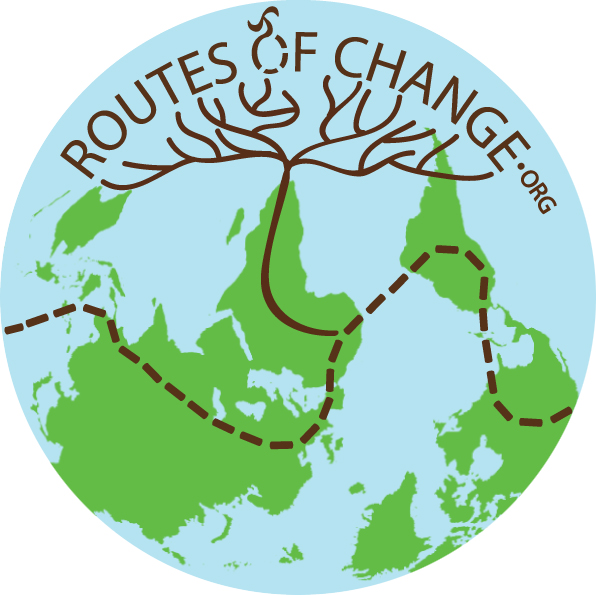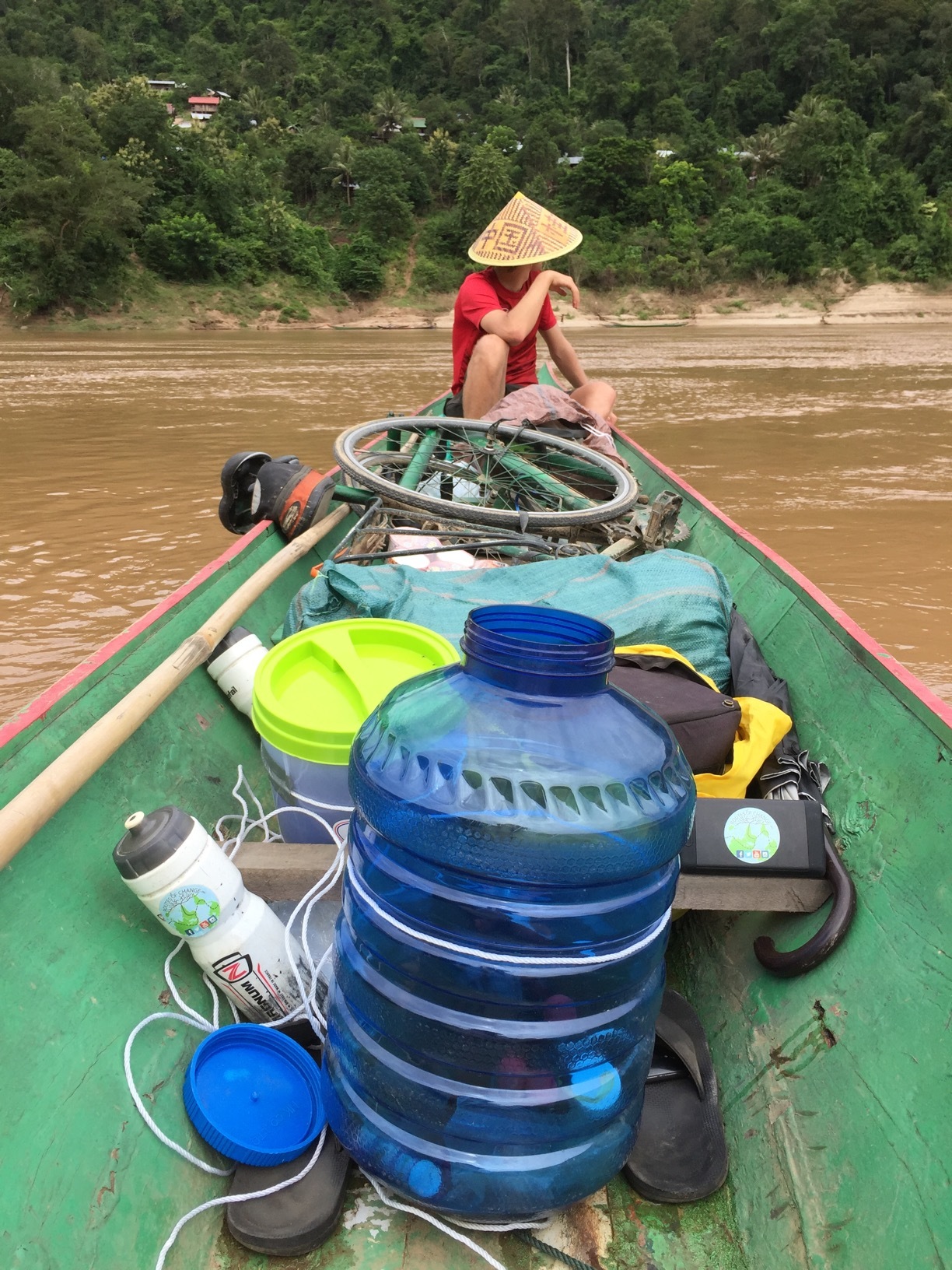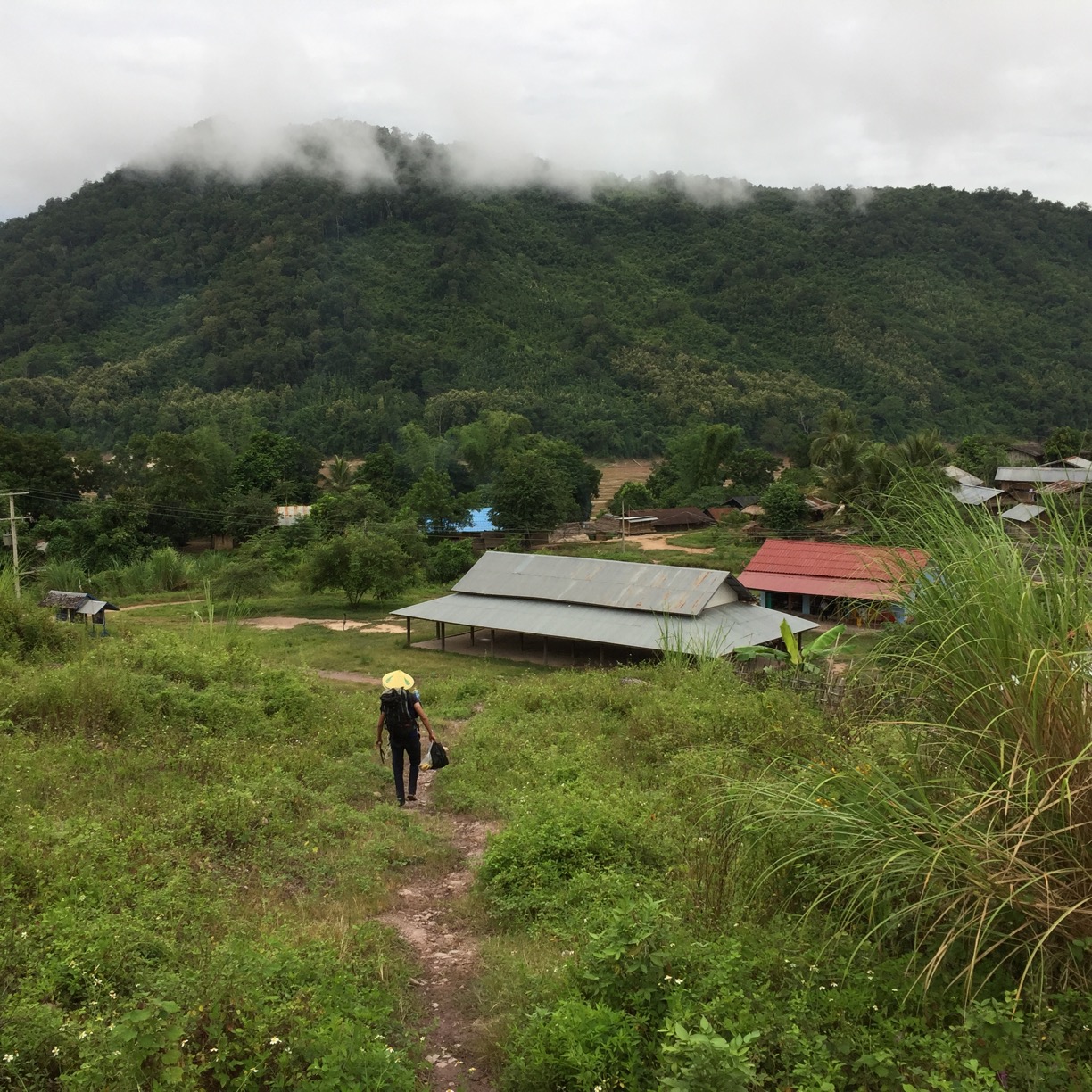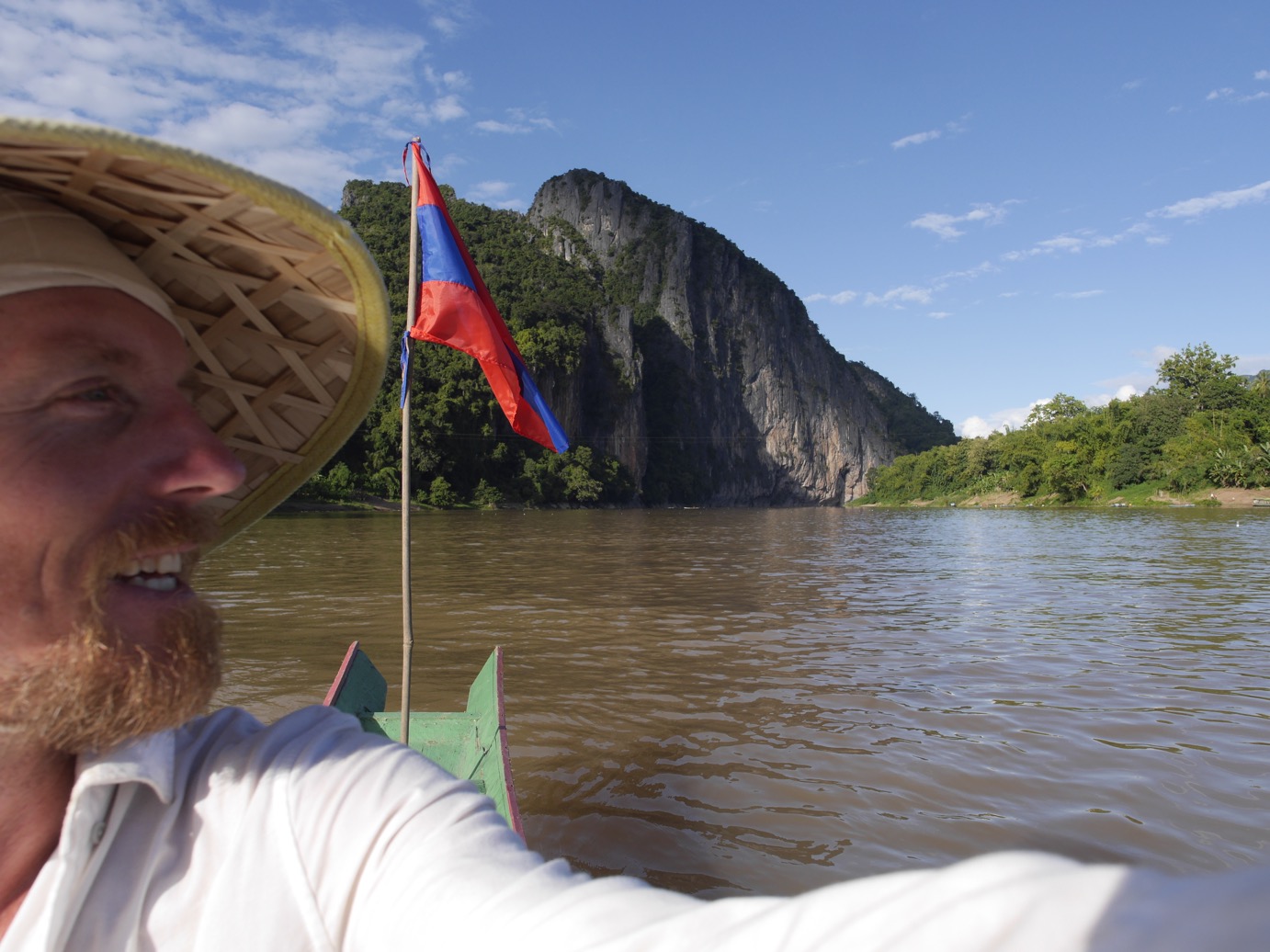First experiences on the river
17 October 2017 - 24 October 2017
This 4 part series of blogs are written by Felix from Germany, who joined me for the adventure down the Mekong River. I have not edited any of the grammar as it portrays his voice better in this form. Thanks Felix!
This morning we finally started. We woke up at about 7am, checked out, went for breakfast, carried our luggage to the boat, packed everything on the boat and made a few test rounds in the boat near the shore. At 9.30am we went down the Mekong. We paddled for about 10 minutes. Thereafter, we mainly just let the current work to bring us down the Mekong. It was a nice sunny day, almost no clouds. The Mekong itself is a pretty muddy brown river. It’s the kind of river where you feel more dirty after a dip in the river than before. That’s why we avoided to take a bath in the river the first few days.
So our first day and so many days to come we mainly spend just floating down the Mekong and enjoying the nature. The nice thing about letting the boat float is that it often starts to spin around. So, you’re just laying there, on the fresh air, surrounded by water, and let the river do the magic for you and show you its beautiful country. It’s comparable to riding a train, but much better. Because you’re not in a bubble, and you additionally get the full 360° view without having to turn your head because the boat is continuously spinning around. It feels like the river is directing a live movie for you and you’re directly into it or you’re watching it through the eyes of the camera man.
My job was basically just paddling. Markus was paddling and steering at the same time. In general, it is much easier to steer the boat from the back than from the front. That’s why Markus was sitting in the back and I was sitting in the front.
Especially, in the beginning I put all responsibility in Markus’ hands, because I knew nothing about traveling on a river. This means, he mostly observed the river for potential dangers, he decided which way we go and he decided how strong I have to paddle. I trusted him blind and never had any doubts on him. It still always felt a little bit kamikaze when we were in uneasy waters, the boat was shacking and i saw all the whirpools, rapids and rocks ahead of us and the only thing I could do was to paddle as hard as I could. Because, if you are in uneasy waters (e.g rapids) and you have to change directions fast to avoid whirpools, rocks in the water or something else the faster the boat moves compared to the water the faster you can change the course. So, whenever we saw some rapids ahead of us we already started to paddle as hard as possible before the rapids to bring the boat on a good speed level. Of course, if we came then in the rapids the boat became really fast and we just kept on paddling as hard as we could to keep the boat on a good speed level compared to the water. Especially, if there were then rocks in the water in front of us which came closer pretty fast, so that I was already thinking this is not going to end good if we hit the rock with our speed. In this situation my job was to paddle even harder. It always felt a little bit like, if we already hit the rock, at least, we want to hit it with the maximal speed that is possible.
However, the Mekong was for the most part of the distance we made on the first day pretty calm. During the times the river was calm we mainly just enjoyed the landscape, listened to music, made some dance moves on the boat and waved to the people on the boats that passed us. From time to time we had to made some course adjustments to guarantee that we have a good floating route. That is that we don’t come into an Eddie that takes us up the river again. And that we keep the boat in the area where the river is the deepest. Because there the water moves the fastest. Before I joined Markus on the boat, I had no idea about all those things I’m writing about now. But, I learned almost everyday something new from Markus.
The most important lesson on the first day I learned when we came into wavy waters. We jumped over the first three or four waves but then the bow dived under the next wave and we became a huge amount of water in the boat. Both of us had a bailer next to us for those situations. Faster than I could think, I had the bailer in my hands to get the water out of the boat. Then, I heard Markus shouting something like: ‘Man, what are you doing?’. First, I didn’t know what he was meaning. But, when I looked back to him I saw him holding my paddle in one of his hands and his paddle in the other hand. So, without consciously realizing I had thrown my paddle in the water to bail out the boat. Luckily, Markus was sitting behind me and could grab it out of the water. The river became calm again after another couple of waves. Thus, we had time to bail out the boat and Markus could give me the maybe most basic lesson: Never throw your paddle in the water. Further, as long as the boat is not close to sink first start to bail out the boat if you’re pass the turbulently water.
As soon as it was past 4pm we decided to stop at the next village to find a place to sleep. Finally, at 4.30pm we finished our first day on the river. We stopped at a small village. On that day we made about 50km. In general, our average velocity was mostly between 5 km/h and 10 km/h without paddling and with paddling we could increase the velocity by up to 10 km/h.
As soon as we reached the shore, we tied the boat to the bamboo stick and a small tree and unloaded our stuff, except Markus’ bicycle. There were only a few people further down the river, so that not many people noticed our arrival. To find a place to sleep we decided to split up. Markus went to the village to ask for accommodation for the two of us and I stayed at the boat to take care of our stuff. It already became dark when I saw a light walking into my direction. It was Markus and he said he arranged a place to sleep for us in the house of a local. So, we grabbed our stuff and started to walk in the village. Markus lead us to a small local shop where the owner of the shop was already waiting for us. He could speak a little bit of English and said that we could sleep at the house of his friend. After we waited a few minutes at the shop his friend arrived to lead us to his house. He couldn’t speak English at all but was very friendly. His house was a very simple traditional wooden Laos’ house. But, he was just building a bigger house next to the other one. His teenage daughter prepared us some sticky rice and eggplant like vegetables. After dinner we kept on talking a little bit more with our host, mainly in body language, and went to bed quite early.
In the morning a TV repair guy came to his house at 7am to fix his old TV. Our host prepared breakfast for us. Again sticky rice with some vegetables and omelette. Thereafter, we packed our stuff, thanked him for inviting us to stay at his house and for the food and gave him some money. At this point, I want to mention that during our whole boat trip we always found a family that invited us to sleep at their house if there was no guest house in the village. Mostly, people were really happy to invite us to their home and to take care of us. They always prepared dinner and breakfast for us and mostly they even gave us some food we could take on the boat for lunch. And never somebody asked us for money. People are just really welcoming in Laos, more precisely in all southeast Asian countries I’ve been to. Nevertheless, we always gave our hosts some money before we left as a small appreciation and compensation for the accommodation, food and everything else. But, I always had a mixed feeling when we gave them money. On the one hand I wanted to give them something, on the other hand it didn’t feel to be the right way to thank them for their generosity and kindness. Because, money is nothing compared to the charity we experienced from our host families. But, luckily our hosts were always happy and thankful when we gave them some money.
As we got up so early we were ready for an early start on the river. However, as soon as we came to the boat there was something missing: Markus’ bicycle. Someone had stolen his bicycle from our boat. Markus reacted quite cool and decided to give it a try to search a little bit in the village. But, he could not find it. Further, he informed the owner of the shop, Mr. Siton, about his loss. Mr. Siton promised to inform the police and to stay in contact with Markus. Thereafter, we were ready to leave, from now on with less weight and more space on the boat.
The second day was again a very hot day. Most of the time we could just float, but from time to time we also came into some rapids and had to dodge big rocks in the water. Whenever, there was a lot of potential danger in the river ahead, Markus stood up observed the river ahead and then decided which route we were going to take, to get into less trouble as possible.. Because, the Mekong is on most parts a pretty wide river there was often one route that was pretty safe to take. However, just as often we could not avoid to go into turbulent waters. Always as soon as we knew that we have to go through some rough waters we waterproofed our smartphones and the speaker to be prepared in case the boat would sink.
At about noon on that day we passed a beautiful small beach. So we decided to stop there for a while to move our legs and to relieve ourselves. Basically, if we had to go for a piss we did it on the boat. We could use the bailers as toilet and then just pour it into the river. But the bigger toilet was a bit more complicated.
About an hour after we left the beach again we saw a small waterfall on the side of the river. As we didn’t have a shower since we left Pak Beng on the first day we decided to stop and wash ourselves in the waterfall.
At about 4.30pm we stopped again at a small village on the side of the Mekong to arrange a place to sleep for the night. This time there were already some villagers at the shore looking amazed what the two Falangs (it roughly translates as a non Asian foreigner) are doing here with the boat. And in a short time we were surrounded by about 30 adults and kids who curiously watched what we were doing. This time Markus stayed at the boat and I went up to the village to ask for a place to sleep. It was a little bit smaller than the last village. The village had about 85 houses, with about 450 people living there. Most of the houses were again really basic bamboo houses and there was no real road, only some small dirty trails. As i arrived in the village i went straight to the first two people i saw. They couldn’t speak English so I used body language to ask if we can sleep here somewhere. One of them immediately made me understand that we can sleep in in his house. So, I explained again with hands and feet that i will go to inform my friend Markus and we would come back with our luggage. 15 minutes later were in the house of our friendly host for the night.
Shortly, after we arrived in the house again a crowd of about 30 people gather inside the house around us and outside peering through the barred windows watching every movement of us. It felt a little bit like we would be strange animals in the zoo. After a while, I went for a bucket shower and Markus started to entertain the kids with a bit of dancing, juggling, beatboxing, handstands and so on. Apparently he performed quite well judging from the cheering and laughing I heard while I had my shower. Thereafter, we went for a small tour through the village, again followed by a big crowd. We came to the school and met one of the teachers who spoke a little bit of English. After a short talk we agreed to teach an English lesson on the next day. When we came back from the tour around the village our host family served some food for us. Mainly sticky rice, eggs and noodles.
On the next day, after breakfast, we grabbed our stuff and went to the school. We taught for a bit more than one hour English. There were about 30 students in the class. We did some basic stuff as the numbers, the alphabet and the head, knees and toes song. The students really seemed to enjoy it. After we finished the class we went to the boat and were back on the river.
About 2 hours after we left the village we stopped again at a small waterfall for a quick dip. Thereafter, we prepared lunch using the sticky rice, which our host family of the last night gave to us. We made a nice rice porridge. As we didn’t have a bowl we used the plastic bag of the rice. We added some banana slices, peanuts and coconut cream and ate with our fingers while making meters floating down the Mekong.
On that day we paddled a bit more than the first two days. One reason was, because there were a lot of critical situations with rapids, whirpools and rocks in the water. The other reason was, because we had a destination for this day we wanted to reach. At about 4pm we arrived at our destination Pak Ou. Me, with slightly tired arms from all the paddling of the last two days and especially that day. But, I quickly forgot about my arms when we arrived, because the scenery was just spectacular. Pak Ou lies directly on the crossing where the Nam Ou river is floating into the Mekong river and there are two huge cliffs not far from the crossing point, one on the side of the Mekong and the other one on the side of the Nam Ou. I had no idea how big they were, but Markus guessed they would be about 200m high.
Pak Ou is also a quite small place and not many tourists stay here over night. Most tourists come here from Luang Prabang by slow boat for a half day trip. We still managed to find an accommodation for a good price. Thereafter, we went for dinner and had some beers with two locals on the river, before we went to sleep.
On the next morning when we were just loading our stuff on the boat three elephants with locals on their back came to the river to take a bath. After watching them for a while we left the shore and went for a short detour up the Nam Ou river to the big cliff. Thereafter, we went back on the Mekong and stopped at the other cliff. We parked our boat next to a slow boat that came from Luang Prabang with a lot of tourists on it. The tourists come here from Luang Prabang to visit the cave that is in the cliff. It’s a quite small cave with a lot of big and small Buddha statues inside.
After we saw the cave we left Pak Ou and headed towards our destination for the day: Luang Prabang. We paddled a good part of the distance and arrived at about 3pm in Luang Prabang. And at about 4pm we had the optimal spot for our boat on the shore to be in walking distance to our accommodation we wanted to go to. We just put it next to some other boats and asked a local guy who was just working there on building a new boat if we could leave our boat there for a couple of days. He agreed and we promised him to bring him a beer on the next day.
We stayed five nights in Luang Prabang. It is a quite nice little town. It was listed as a UNESCO world heritage site in 1995 due to its cultural and natural features. The architecture of the center is strongly influenced by the European colonies in the 19th and 20th centuries. I think for me it was the most non-Asian looking city I saw so far during my time in Southeast Asia.
We didn’t really do much during our stay in Luang Prabang. We just enjoyed to be in one place for a few days and having a huge variety of food options. But, one day Mr. Siton called and said that he had found Markus’ bicycle. He said that he found it in the river when the water sunk and that he thinks that someone took it and left it there. Mr. Siton said hat he will send the bicycle down the river on a boat the next day. We we’re both stoked. Mr. Siton made it. So, we asked at our hostel where the boat would arrive and the hostel owner offered us to bring us there on the motorbike the next day. As Markus cannot go on motorbike I went with the hostel owner on the next day to the port. At the port the bicycle was really already waiting for us. I just had to sign a paper and then rode it back to the hostel. Sometimes things are going really easy in Asia.
















































